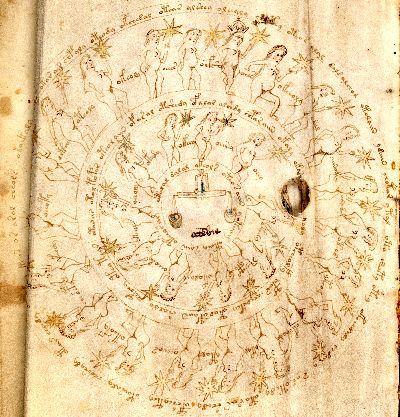For years, it has been suggested that the structure of the Voynich Manuscript’s “zodiac” section (where each 30-degree sign has 30 nymphs / 30 stars linked to it) might be encoding some kind of per-degree astrology information. Famously, Steve Ekwall claimed that an “Excitant Spirit” had told him the types of star here denoted the outcome of conception (i.e. a male birth or female birth). This would have been either from the precise degree that the moon was passing through at the time of conception, or from the precise time when the question was asked of the astrologer.

Voynich Manuscript page f72v1 – Libra (contrast-enhanced)
Interestingly, there is also a substantial modern literature on per-degree astrology, usually known as “Sabian Symbols”. The best-known set of these was drawn up by Marc Edmund Jones in San Diego in 1925 (you can see it on pp.10-26 of this Italian PDF): this was later refined and popularized by Dane Rudhyar (and others).
Yet Jones was building (to a certain degree, one might say) on the work of two nineteenth century astrologers / psychics: Charubel [John Thomas] (1828-1908) and the colourful Theosophist Sephariel [Dr Walter Gorn Old] (1864-1929). There’s a 1998 biography of the latter by Kim Farnell called “Astral Tramp” (Blavatsky’s nickname for Walter Old). [Review] Charubel & Sephariel’s 1898 “The Degrees of The Zodiac Symbolized” contains two 360-degree lists that are, it has to be said, wildly different.
On the surface, this would appear to be two completely parallel, relatively modern, and entirely unconnected re-inventions of the sort of (probably originally Arabic) per-degree astrology described by Pietro d’Abano – and so something Voynich researchers should perhaps strive to walk around rather than to engage with.
Certainly, Charubel’s list was specifically described as having been channeled: yet Sephariel claimed that he had actually translated the symbols from a very old book called “La Volasfera”, by Antonio Borelli (or Bonelli) – and so there is, right at the core of the whole modern Sabian Symbol tradition, a very specific claim to a lost Renaissance parentage. Unfortunately, nobody has (as far as I can tell) since tracked down this lost author or this lost book, so Sephariel’s claim might… just… possibly… not be entirely truthful. Really, it’s hard to say, particularly as Sephariel was so, well, unreliable. Oh well!
If you want to read more about Sabian Symbols, there is a surprisingly large amount of literature: the Astrological Center of America maintains a pair of webpages (here and here) listing numerous books on Sabian Symbols and on other per-degree systems (respectively).
Finally, here’s an example of modern astrologers’ describing and using Sabian symbols, which might help make it clear how they are broadly intended to be used.